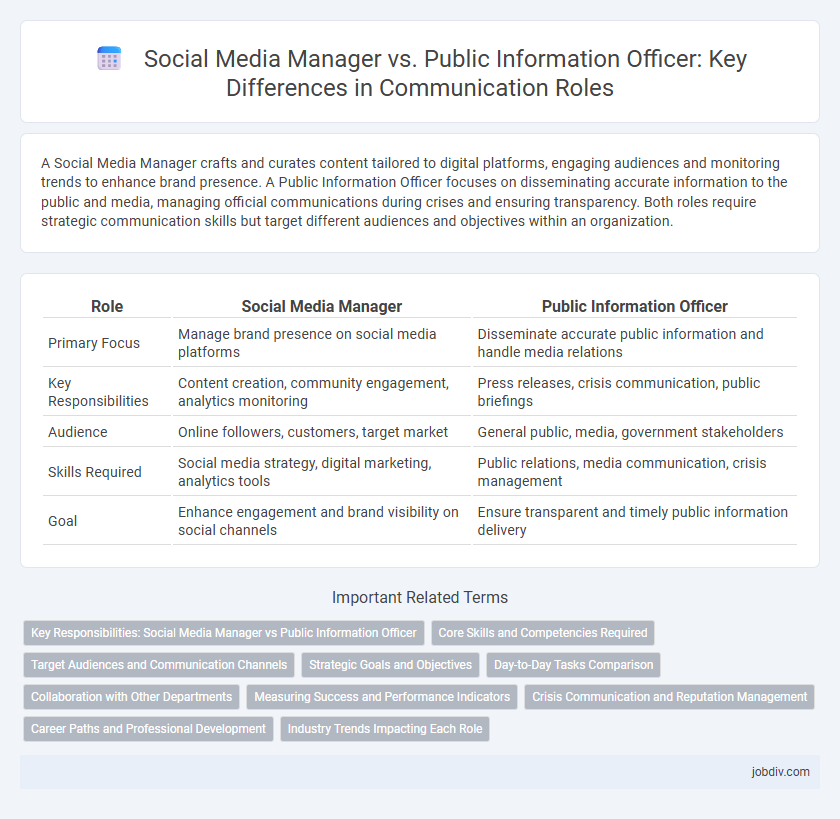A Social Media Manager crafts and curates content tailored to digital platforms, engaging audiences and monitoring trends to enhance brand presence. A Public Information Officer focuses on disseminating accurate information to the public and media, managing official communications during crises and ensuring transparency. Both roles require strategic communication skills but target different audiences and objectives within an organization.
Table of Comparison
| Role | Social Media Manager | Public Information Officer |
|---|---|---|
| Primary Focus | Manage brand presence on social media platforms | Disseminate accurate public information and handle media relations |
| Key Responsibilities | Content creation, community engagement, analytics monitoring | Press releases, crisis communication, public briefings |
| Audience | Online followers, customers, target market | General public, media, government stakeholders |
| Skills Required | Social media strategy, digital marketing, analytics tools | Public relations, media communication, crisis management |
| Goal | Enhance engagement and brand visibility on social channels | Ensure transparent and timely public information delivery |
Key Responsibilities: Social Media Manager vs Public Information Officer
Social Media Managers focus on content creation, community engagement, and analytics to enhance brand presence across platforms like Facebook, Twitter, and Instagram. Public Information Officers are responsible for media relations, crisis communication, and disseminating accurate information to the public and government stakeholders. Both roles require strategic communication skills but differ in scope, with Social Media Managers prioritizing digital interaction and Public Information Officers emphasizing official information dissemination.
Core Skills and Competencies Required
A Social Media Manager must excel in digital content creation, analytics, and community engagement to craft targeted campaigns and optimize brand visibility across platforms. In contrast, a Public Information Officer requires strong crisis communication skills, media relations expertise, and the ability to convey clear, accurate information to the public and stakeholders. Both roles demand strategic thinking, proficiency in communication tools, and adaptability to evolving digital and public landscapes.
Target Audiences and Communication Channels
Social Media Managers primarily target digital-savvy audiences across platforms like Facebook, Instagram, and Twitter, leveraging social media channels to engage users through interactive content and real-time updates. Public Information Officers focus on broader community outreach, including journalists, stakeholders, and the general public, utilizing traditional media channels, press releases, and official statements to disseminate accurate and authoritative information. Both roles prioritize audience-specific communication strategies, but Social Media Managers emphasize digital engagement while Public Information Officers maintain formal, wide-reaching public communication.
Strategic Goals and Objectives
A Social Media Manager focuses on driving brand engagement and expanding audience reach through targeted content strategies on platforms like Facebook, Instagram, and Twitter, aligning with marketing goals to increase visibility and customer interaction. In contrast, a Public Information Officer prioritizes transparent communication and timely dissemination of accurate information to the public and media, supporting organizational objectives related to trust, accountability, and crisis management. Both roles strategically contribute to organizational communication but differ in their primary objectives: social engagement versus public trust and information accuracy.
Day-to-Day Tasks Comparison
Social Media Managers focus on creating and scheduling content, engaging with online audiences, and monitoring social media analytics to optimize brand presence across platforms like Facebook, Twitter, and Instagram. Public Information Officers handle drafting press releases, coordinating media inquiries, and managing official communications for government agencies or organizations to ensure accurate public messaging. Both roles require strong communication skills, but Social Media Managers emphasize digital engagement strategies while Public Information Officers prioritize formal information dissemination and crisis communication.
Collaboration with Other Departments
A Social Media Manager leverages cross-departmental collaboration by coordinating with marketing, sales, and customer service teams to ensure consistent branding and timely response to audience engagement on social platforms. A Public Information Officer partners closely with legal, emergency management, and government agencies to disseminate accurate, official information during crises or public announcements. Both roles require strategic alignment but differ in scope, with the Social Media Manager focusing on dynamic content creation and community interaction, while the Public Information Officer prioritizes transparent, vetted communication for public trust.
Measuring Success and Performance Indicators
Social Media Managers gauge success using metrics like engagement rates, follower growth, click-through rates, and sentiment analysis to optimize content strategies. Public Information Officers measure performance through public awareness levels, message penetration, media coverage quality, and response times during crises. Both roles rely on data-driven insights but emphasize different indicators aligned with their communication goals and audience reach.
Crisis Communication and Reputation Management
Social Media Managers leverage platforms like Twitter and Facebook for real-time engagement during crises, enabling rapid response and public sentiment monitoring. Public Information Officers coordinate official statements and manage information dissemination to ensure accuracy and maintain institutional credibility. Both roles are critical for reputation management, but Social Media Managers emphasize interactive dialogue while Public Information Officers focus on authoritative communication.
Career Paths and Professional Development
Social Media Managers typically advance by mastering digital content creation, analytics, and platform-specific trends, often progressing to roles such as Digital Marketing Director or Brand Strategist. Public Information Officers focus on building expertise in media relations, crisis communication, and government or corporate messaging, frequently moving toward Public Relations Director or Communications Manager positions. Both career paths demand continuous professional development through certifications in communication strategies and emerging technologies to stay competitive.
Industry Trends Impacting Each Role
Social media managers increasingly harness AI-driven analytics and real-time content personalization to boost engagement across digital platforms, shaping dynamic marketing strategies. Public information officers adapt to heightened public demand for transparency by utilizing advanced crisis communication tools and multimedia storytelling techniques to maintain trust and credibility. Both roles navigate evolving privacy regulations and platform algorithms, requiring continual upskilling to manage public perception effectively in a rapidly changing media landscape.
Social Media Manager vs Public Information Officer Infographic

 jobdiv.com
jobdiv.com